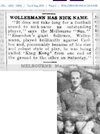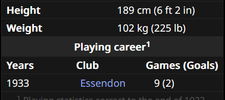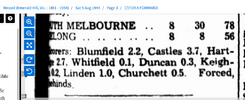RedmanWasHere
Rarely in kitchens at parties.
- Aug 23, 2010
- 28,917
- 35,171
- AFL Club
- Essendon
- Other Teams
- Exers, Gryffindor, Rich+Ess AFLW, Tassie
Relton Roberts is surely the only 2 game AFL player who has his own wikipedia page.
Two games, two 9 goal losses.
Carlton 18.12.120 def Richmond9.10.64
Sydney 16.15.111 def Richmond 7.14.56
I reckon all the 1 game names have their own entries.










